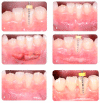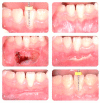Diode versus CO2 Laser Therapy in the Treatment of High Labial Frenulum Attachment: A Pilot Randomized, Double-Blinded Clinical Trial
- PMID: 33105594
- PMCID: PMC7659929
- DOI: 10.3390/ijerph17217708
Diode versus CO2 Laser Therapy in the Treatment of High Labial Frenulum Attachment: A Pilot Randomized, Double-Blinded Clinical Trial
Abstract
Background: The labial frenula are triangular plicas departing from the alveolar mucosa and attaching themselves at different heights of the gingiva. Sometimes a high attachment can determine a gingival recession. The most suitable surgical resolution is the use of laser devices. The aim of this study was to compare the labial frenulectomy through the use of Diode and CO2 laser techniques in pediatric patients with a high labial frenulum attachment, clarifying at the same time the preventive role of the surgical treatment to avoid further recession. Methods: A pilot randomized, double-blinded clinical trial was conducted to compare both the surgical advantages and the preventive treatment of laser technology using two different wavelengths within a population of pediatric patients with a high labial frenulum attachment. Different parameters intra and post-surgery were taken into account (Bleeding, Wound Healing, Gingival Recession, Periodontal pocket and Numerical Scale Value for pain) to compare Diode versus CO2 laser therapy. Results: Although both the laser devices provide a good performance in the post-operative period, the Diode laser shows better results (p < 0.001) in three of the five parameters evaluated. Conclusions: From the results it was found that the Diode Laser device is more suitable compared to the CO2 device.
Keywords: CO2 laser; Diode laser; frenulectomy; labial frenulum; laser therapy; pediatric dentistry.
Conflict of interest statement
The authors certify that there is no conflict of interest with any financial organization regarding the material discussed in the manuscript.
Figures


References
-
- McDonald R.E., Avery D.R., Dean J.A. McDonald and Avery Dentistry for the Child and Adolescent. 10th ed. Elsevier; Amsterdam, The Netherlands: 2015. Examination of the Mouth and Other Relevant Structures; pp. 1–18.
-
- Placek M., Skach M., Lubor M. Significance of the Labial Frenum. Attachment in Periodontal Disease in Man. Part 1. Classification and Epidemiology of the Labial Frenum Attachment. J. Periodontol. 1974;45:891–894. - PubMed
Publication types
MeSH terms
LinkOut - more resources
Full Text Sources

